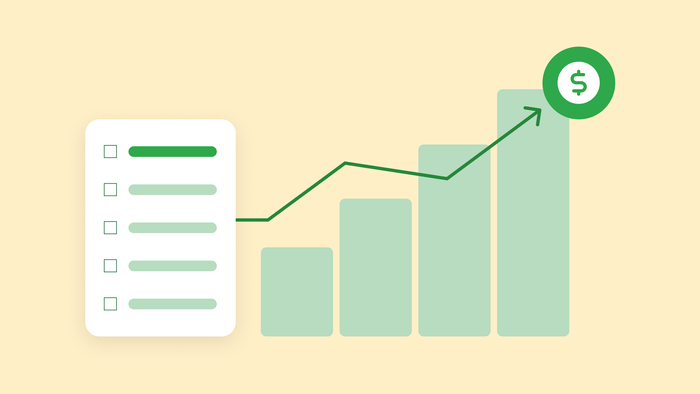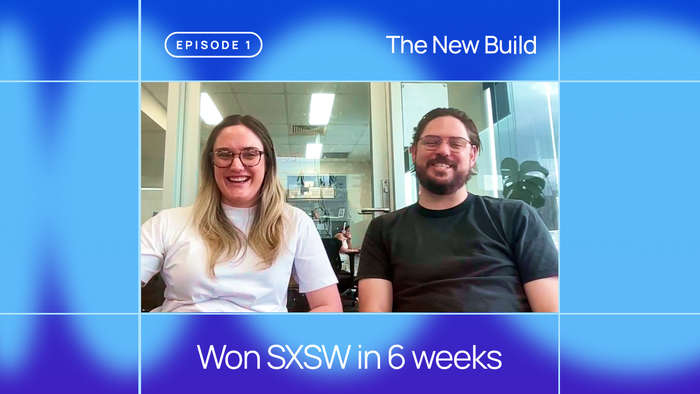When they first co-founded Bubble, Emmanual Straschnov and Josh Haas already had big plans. “We wanted to be able to grow the team to realize the vision of Bubble to be a true “no-code” platform," says Straschnov.
That vision would have required a lot of money right out of the gate. "But,” Straschnov adds, “we wanted to stay focused on being sustainable and delivering value to customers first.”
Josh and Emmanuel bootstrapped Bubble for seven years before ever raising outside funding. They grew the company by focusing on building the product’s functionality and growing their tight-knit and supportive customer base.
In this guide, we’re sharing some of Josh and Emmanuel’s biggest lessons and takeaways from bootstrapping Bubble, as well as best practices and steps to follow to successfully bootstrap your own business.
Bootstrapping basics
If you’re already familiar with bootstrapping and you’re planning to self-fund your startup, you can jump straight to the “How to Bootstrap your Business” section below. If you’re a bit newer to bootstrapping, here are the basics you need to know first:
What is bootstrapping?
Bootstrapping is the process of launching and growing your startup using your own money: personal finances, savings, and so on. The term comes from the idea of “pulling yourself up by your own bootstraps.”
It’s also known as “self-funding.” Bootstrapped companies don’t raise funding or trade equity to finance their company. Instead, they leverage the founders’ personal resources alongside early profits and revenue to keep things going.
Is bootstrapping a good option?
Some people view bootstrapping as a second-tier option — a fallback for those who can’t raise funding or get external support. However, that’s really not the case.
Bootstrapping, as with any funding option, has benefits and drawbacks:
How to bootstrap your business
Bubble started over a meeting across a coffee shop and a laundromat. But once you’ve got your business idea, and you’ve decided to bootstrap it, you need to make an actual plan. It doesn’t need to be extremely formal or complicated, but putting in the right preparation will take you a lot further and set you up for success.
Phase I: Prepare
Figure out your costs. Understanding how much it will cost to get your startup off the ground sets the stage for what you need in terms of funding.
Of course, this is a lot easier said than done.
The costs to start a business can range from almost nothing (for a sole proprietorship online business, for example) to hundreds of thousands of dollars (i.e., for a local restaurant).
Be honest with yourself about:
- What expenses you’ll have to cover
- How much income you’ll need from the business to make it worth it
- What potential revenue you expect from your business initially
Business costs can be tricky to determine. Use our guide to startup business costs to figure out what you should budget for.
Make a thorough business plan. Your business plan details your business goals, your product or services, your target market, competitive analysis, funding plans, marketing and sales plans, and how you plan to develop and operate your business.
Creating a business plan will help you establish product-market fit more quickly, align with your team or contractors on business goals, and grow your company.
You can also use your business plan to think through alternate funding options and what you’ll do if bootstrapping doesn’t work out.
Determine your runway. Your runway is the amount of time (usually in months) that your business can survive given your current expenses and the amount of cash you have on hand. (You can use a runway calculator to understand your current cash balance, forecast your burn rate, and predict your growth.)
Most startups aren’t profitable for at least 18–24 months after launching. It’s a good idea to have at least 24 months of runway (i.e., cash on hand) to cover expenses until you reach the break-even“ point. Bubble’s first paying customer arrived in the first year, but we didn’t reach profitability until several years after that.
Determine viability. Based on your business plan, expenses, and predicted revenue, you can then decide if bootstrapping is a smart option for funding your business.
If you need to hire a lot of employees right away (i.e., a local restaurant) or have a lot of upfront costs such as expensive equipment or expensive assets, bootstrapping might be difficult.
Bootstrapping is best for companies who can develop a product quickly and efficiently (i.e., a digital product made with a no-code tool, like Bubble). Even better if that product has a straightforward revenue model that can start creating revenue right away. Low expenses upfront plus a high potential for revenue is the perfect combination for successful bootstrapping.
Phase II: The early days
Choose the right team. Almost nothing is more important in the early stages of bootstrapping than making sure you only make essential hires who are on board with your vision and goals. For many startups, your “team” early on may be just you and your co-founder.
That was the case for Josh and Emmanuel. Though Josh was hoping to bring on a co-founder who could help with the business side of things, Bubble’s product still needed a lot more work. Josh picked up a book on JavaScript and CoffeeScript at Barnes and Noble for Emmanuel, who essentially trained himself into a frontend developer for Bubble.
Startup founders generally need to wear a lot of hats and be willing to learn whatever needs to be done. This will keep your costs low and allow you to keep forward progress even when resources are limited.
However, keep in mind that you don’t need to do everything by yourself. You can outsource all kinds of things, such as:
- Legal
- Financial bookkeeping and accounting
- Administrative tasks
- Marketing and sales
- Technical development
Depending on where your skills and interests lie, it can sometimes be more cost- and time-effective to outsource than to do it yourself.
Choose aligned tech. As you start to build your team, product, and business, you’ll want to settle on a tech stack. Your tech stack is all the tech that powers your company, on both the frontend (i.e., your product) and the backend (i.e., company processes and operations). A good tech stack is essential not just for your digital product, but also for running your business.
As a bootstrapped startup, you’ll want to choose a tech stack that:
- Can grow with you as you expand and scale up
- Uses as few tools as possible to get the job done
- Has a reasonable cost for the ROI
When it doubt, start with a monthly trial. If you end up using it less than you thought, you can always drop the subscription.
Focus on profitability. As a bootstrapped startup, you’ll almost certainly need to focus on revenue right from the start.
This can be a hidden advantage. It forces you to develop a sustainable business model from the beginning, rather than relying on cash you don’t have or aren’t earning.
This need heavily influenced Josh and Emmanuel’s approach as they built Bubble. Instead of investing a lot of external funding into marketing, they relied on word of mouth from early customers to drive revenue and extend their runway. Because they were bootstrapping,
Because they were bootstrapping, they were able to focus on improving the product to get early traction instead of worrying about outside investors’ concerns.
Maintain an MVP focus. By focusing on your most essential features first, then launching and iterating, you have a better chance of establishing product-market fit and driving real connection and excitement among your early users.
You can start with the basics, then iterate to design exactly what they need and solve their real problems with the product.
With a no-code development platform like Bubble, the time, resources, and cost needed to build your MVP is also much lower, meaning you can launch and start growing your audience and driving revenue even faster.
Even better, Bubble is a full-stack development platform, which means you can continue iterating far beyond your MVP, all in one place.
Cut unnecessary costs. The less you spend on expenses, the longer your runway, even with limited cash. Cost-conscious decision-making will also make it easier to maintain a healthy cash flow.
For example, you might consider swaps like:
- Using a coworking space or working remotely from home rather than renting a dedicated office space.
- Building on a no-code development platform instead of hiring a dev team for traditional coding. No-code tools require fewer resources and investment for product development and allow you to build, launch, and iterate faster.
- Hiring generalists or working with contractors instead of trying to hire full-time employees, especially early on.
- Leasing equipment and software instead of buying it. With so many SaaS tools available now, monthly or annual subscriptions can reduce your upfront costs and give you more flexibility to shift to other tools as needed.
Be willing to pivot. Many successful companies started out building and selling one product before eventually spinning off into a completely different product that customers needed more. In some cases, they end up focusing on what they initially thought would be a small feature or element of their product.
Mailchimp is a great example of this. In the beginning, Mailchimp’s founders were focused on serving major corporate clients via their web design agency. On the side, they created an email marketing service and platform for small businesses and entrepreneurs.
Eventually, they realized that their side-project email software had much more potential, and pivoted to focus fully on Mailchimp. Today, Mailchimp does $800 million+ in annual revenue.
Keep in touch with your users and do regular user testing and user feedback analysis. This will help you pinpoint the most important aspects of your product and solution so you can double down on them.
Build your network and connect with peers. Building your target audience and customer base is a must. Just as important, though, is building your personal network.
Networking opportunities can give you the necessary support to endure the highs and lows of bootstrapping your startup. A good network can offer guidance, provide recommendations, help you test and iterate on your product, nail your positioning, and more.
As a bootstrapped company, you’ll miss out on the valuable connections that come with venture capitalist funding, so you’ll need to devote time to building them on your own. You can consider joining communities like Startup Grind or No-Code Founders to compare notes and look for mentors.
Phase III: Maturity
The goal of bootstrapping your startup is to eventually not be bootstrapping your company. At some point, you’ll need to transition away from using your personal savings.
What comes next? Typically, one of three options:
Raise other funds. Many successful bootstrapped startups go on to raise funding from venture capital firms after solidifying their product. That’s what Josh and Emmanuel did at Bubble.
By the time Josh and Emmanuel decided to raise their first round of funding, Bubble had over 250,000 users, $1 million in annual recurring revenue, and a scalable platform with a small but mighty in-house team. This strong background and stable growth over the past seven years meant Bubble could raise over $6 million from angel investors, then a $100M Series A round two years later. Venture funding isn’t the only external funding you can raise. Some companies might build an audience first, then crowdfund from that audience. You could also use peer-to-peer lending to raise funds from others in your space.
Reach sustainable profitability. Another option is that you become a profitable business and become self-sustaining through funds generated through your business. By the time Bubble raised funding, we’d already been self-sustaining for two years, funded by organic revenue. Reaching profitability is a massive milestone for startups. It can give you an opportunity to build your cash reserve, take on new projects, and scale up your business. While raising funding can give you resources to move and scale faster, it’s not right for every business. Slow, sustainable growth that’s funded by your own revenue and profits is always a valid way to continue growing your business.
Call it quits. Finally, not every startup makes it past the “startup” stage. About 10% of startups fail within the first year, and about 50% fail by year five. When you’re bootstrapping, you take on a lot of the risk associated with your business, which makes it especially important to know when to call it quits. There’s no shame in closing up shop if things aren’t working. You can take away important lessons and apply what you’ve learned to your next endeavor — as so many successful entrepreneurs have done before you.
Four tips for bootstrapping from our founders
We asked Josh and Emmanuel for a few of their best tips for bootstrapping, aside from the obvious. Here’s what they said:
Talk to your customers.
Our customers have always been a huge part of Bubble’s growth, development, and success. In the beginning, especially, keeping in close touch with your customers will help you develop the most effective product for them and develop strong word-of-mouth marketing and customer loyalty.
“Not raising external capital actually helped us a lot to foster [Bubble’s] community. Users value our independence and the fact that users are our only stakeholders. They feel that they have a stronger voice in our decisions (and they do!).” — Emmanuel Straschnov, Bubble co-founder
Stay true to your values.
When you bootstrap, you get to have full control over your business, and the vision, direction, and progress your business makes. Use this to your advantage to stay true to your values and vision for the product!
If you’re in close communication with your customers, it should also allow you to iterate and develop the product that customers really want and need.
In our case, early meetings with investors didn’t sit right with Emmanuel and Josh.
“We got a lot of advice from VCs at the time… to ‘pick a vertical and make the product more specific to some use case.’ That didn’t sit right with us. The big question at the time was, ‘Do we dumb it down for people?’ But we didn’t want to compromise on Bubble’s functionality and freedom. The most important goal for us was to build a tool that could do anything.” — Josh Haas, Bubble co-founder
“We wanted to be able to grow the team to realize the vision of Bubble to be a true “no-code” platform. But we wanted to stay focused on being sustainable and delivering value to customers first.” — Emmanuel Straschnov, Bubble co-founder
Bootstrapping can be a major advantage in allowing you to stay true to your values and goals for your company, so don’t lose sight of these along the way! Your customers will thank you as well for staying true to their needs from your product.
Revisit your funding decisions regularly.
One risk with bootstrapping, Emmanuel points out, is that “if things are taking longer by bootstrapping [vs. raising money], you can find yourself working on something for ten years before realizing this wasn’t even your initial vision. Turning your company into a lifestyle business is great, if that’s what you want. But it may not be.”
Instead, “make sure to revisit your decision [to not raise funds] every six months or so, don’t just fall into a comfortable rhythm.”
With Bubble, Emmanuel and Josh were both convinced of the power of no-code and sure that they could build a solution to the problem they were tackling. However, bootstrapping isn’t the long-term answer for any successful business.
Revisiting your decisions regularly will help you analyze your funds and runway, make smart financial decisions, and help you decide when it’s time to raise funds, hire a team, or scale via your own internal revenue.
Remember it’s okay to go slow.
As Emmanuel points out,
“A common way of thinking now is, ‘If you’re not embarrassed when you launch, that means you waited too long.’ I’m not sure how much I believe that one. We certainly believe in iteration and collecting feedback, but we always felt that if we were going to actively push Bubble publicly [i.e., via ProductHunt or raising funding], we wanted to feel confident about what we built.
I’m glad we waited; I’m certain the documentation and the lessons we had helped a lot with conversions.”
No product is an overnight success.
In any startup, there are long years of experimenting, building, iterating, trying again, breaking things, building and rebuilding, learning, and — maybe — finally finding what works.
But don’t be afraid to keep things small and focus on your core users first before launching to a wider audience. The stronger your product is for your core market, and the stronger your product-market fit, the better chance of success you have when you’re ready to scale.
Bubble makes bootstrapping easier
Bubble is here to make it easier for founders of all types and backgrounds to be able to build, launch, and grow your product.
When you build on Bubble, you leverage a full-stack development platform that lets you build complex web apps and tools without coding. This means you can move faster, build your product yourself (instead of hiring a team of engineers), and save time and money.
Bootstrapped startup founders love Bubble for its flexibility, speed, and cost-effectiveness.
Don’t believe us? Just ask Flexiple founder Karthik Sridharan. Karthik says, “the level of empowerment Bubble gave me was great, and the speed with which we could build was so much quicker.” They built their app on Bubble, and then bootstrapped their way to $3 million in annual revenue.
Build for as long as you want on the Free plan. Only upgrade when you're ready to launch.
Join Bubble





